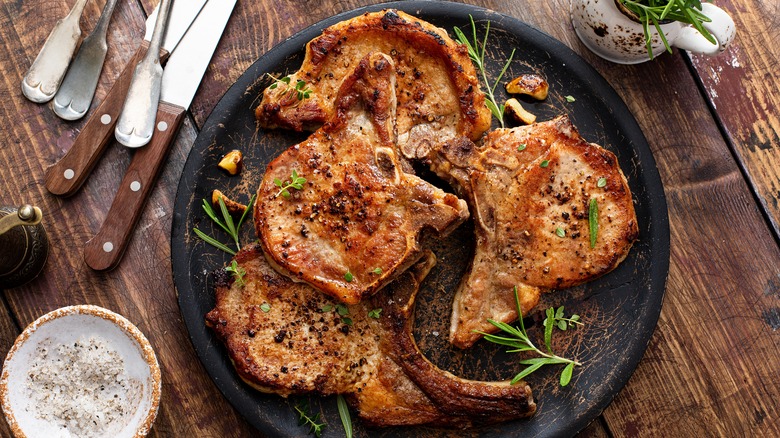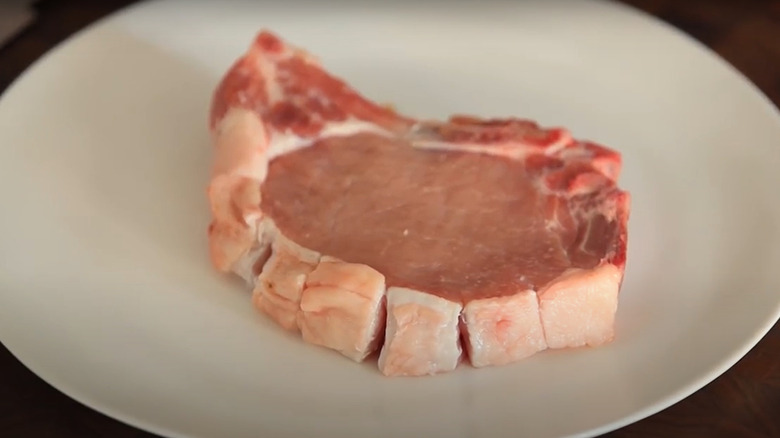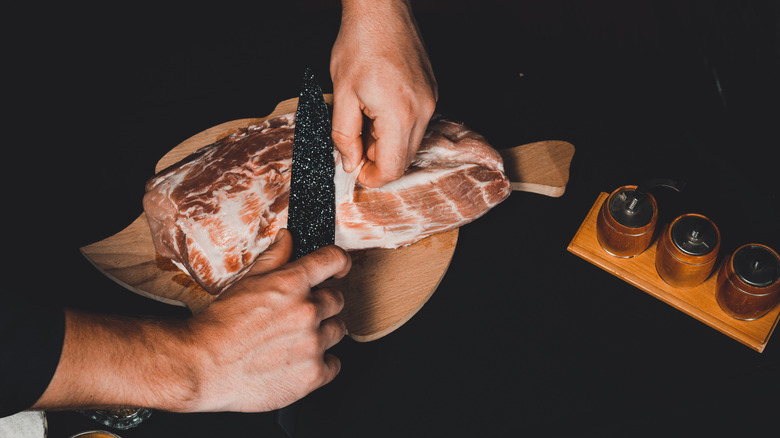Why Pork Chops Curl In The Pan And How To Make Them Stay Flat
Whether you call it buckling, curling, or cupping, that phenomenon whereby pork chops curve upward around the edges while searing in the pan is one of the most annoying things about cooking chops. You can't ignore it because, the more the meat sides lift off the pan, the higher the potential for uneven cooking. Not to mention the missed opportunity for those raised surfaces to remain in contact with the hot pan and form a perfectly even sear. So what causes this curling effect? It's all about how the fat cap reacts when heated in contrast with the rest of the meat.
Most pork chops feature a strip of fat that runs across the outer edge of the meat. As the cut of meat heats up in the pan, the fat melts and loses moisture faster than the adjacent meat, which causes it to shrink more, become taut, and therefore pull at the rest of the meat in the center of the chop. You'll notice that thicker cuts of meat tend to be less affected by this phenomenon because the weight of the meat keeps it down, while thinner pork chops will buckle more. Luckily, there's a quick and simple solution: scoring.
Score the fat cap to prevent curly chops
Scoring the fat pad is how you avoid the cupping effect on pork chops. This is a case where prevention is the cure, so it's better to implement this step before placing your chops on the pan. Working on one pork chop at a time, hold it up vertically for a clear view of the fat pad, then use a small sharp knife to cut slits across the fat but stop right before cutting through the meat. The slits don't have to be too close together — about half an inch to 2 inches apart is okay.
Beyond solving the curling problem, scoring the fat pad results in a deliciously crispy fat layer. You see, for every slit you make, you create extra edges that easily crisp during searing resulting in a delightful crunchiness that blends perfectly with the rest of the seared meat. So it's actually a good idea to cut more slits, even a crosshatch pattern, if you'd like to maximize this added benefit.
After scoring the raw pork chops, season as usual, pat dry with paper towels to remove excess water, and you're ready to cook. Some people recommend first placing the pork chop upright on the pan (with the fat side down) to render the fat before searing the meat. That's one way that works. But you can also proceed with the traditional route of searing the meat surfaces first.
What not to do to prevent curly chops
If you're seated there wondering: Since the culprit of the pork chop's curling phenomenon is the fat cap, can't we just cut out the fat completely? Won't that solve the problem at once? Well, it's not that simple. Technically speaking, getting rid of the white cap can indeed prevent your chops from curving when heated in the pan. However, you'll be depriving yourself (and your fellow diners) of a much greater benefit — flavor.
The meaty flavor of cooked pork chops (and any other meat for that matter) as we know it, originates from the fat component of the meat. This is why well-marbled cuts and more flavorsome than the leaner portions. Once rendered, the outer fat imparts its moist nature and buttery taste to the entire meat resulting in a succulent finished dish that's more enjoyable to consume. Plus, when pan-searing pork chops, the melted fat comes in handy during basting as the meat gets to bathe in its natural juices.
However, if you feel like the fat content is a bit much and are worried about ending up with a greasy dish, you can do one of two things. Either trim out part of the fat and leave a thin layer or go ahead and cook the meat as is, then discard the rendered fat afterward and cut off any fat layer still attached to the chops. This way, you'll still gain the flavor benefit of the fat.


